Roots on the Ground
Part 2 of a guest essay on food security.
Part Two: Roots on the Ground
How do you grow food? Well that depends entirely on where you are and what land and living situation you can develop, but let’s look at a few examples.
With only 2% of the US population in agriculture, let’s dispense with the idea that you’re a farmer or have the land to do so. But that would not help you anyway: during a crisis running one of the new thousand acre farms with their inputs of imported oil, machine parts, cash and clearing from the digital banking and commodity systems will be impossible. A huge portion of the food grown in North America is on a large scale hundreds or thousands of miles from their market, while at the same time the massive scale of the distant infrastructure means nothing will run without an uninterrupted supply of oil, seeds, fertilizers, machines, and money.
During Russia’s 1998 currency crisis, an abundant wheat crop planted at great expense the year before was unable to be harvested due to an interruption of money that led to a limited supply of diesel fuel. Without fuel, the combines sat idle while the crop rotted and was overcome by winter. Without harvest, there was no seed to plant next year’s crop, nor was there money to buy next year’s diesel to till and plant in spring, leading to years of economic hardship as the nation slowly adjusted and rebuilt.
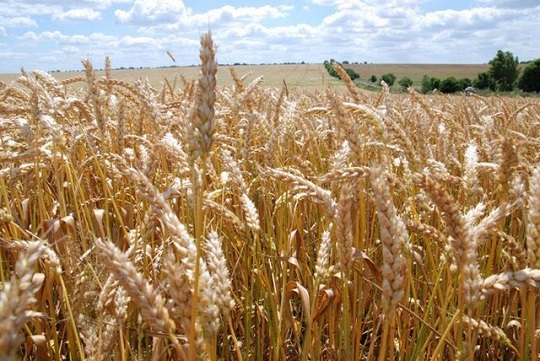
With wheat fields like this, neither could you find a million scythes to send men to harvest, a billion bags for the threshing, local elevators for the storing, or trains for the delivering. Sure, the farmer might eat, but if the money system stops even for a month, he is just as likely to default on his mortgage and be out on the street as you are.
In any case, statistically you are not a farmer, nor are you near one. So let’s take the best case: you live on little-to-no land in the Northeast or Midwest. How do you get food security? First plant a tree.
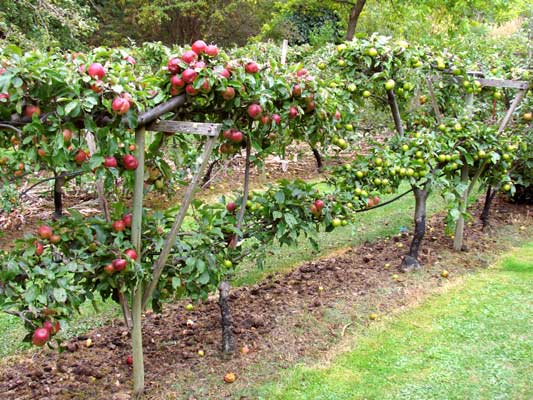
Each apple can produce from 40–200 kilograms (88–440 lb) per year, but as they take 5 years to bear you’ll need to start early. Other fruits are similar. Chestnuts and walnuts can produce 100 lbs per tree. Working up the walls and fences, you’ll get about 10 lbs of grapes per vine.
In the garden you’ll find tomatoes at 50 lbs/plant or 40 tons per acre, squash at 10 lbs per plant or 12 tons per acre, 10 tons/acre for cabbage, and 16 tons/acre for potatoes.
Grains are 2,500 lbs/acre for wheat, 3,200 for oats, and 6,000 lbs/acre for corn, 3,500 lbs/acre for dry beans.
Fancy eggs? Each chicken needs about 9 square feet and produces 300 eggs per year.
What does this add up to? Let’s say you have a ¼ acre yard to work with or 11,000 square feet. Assume for the moment that placement of trees, chickens, vertical growing of fences and espalier trees allows all of it to be used. That’s 6,000 pounds of squash, 8,000 pounds of potatoes, 20,000 pounds of tomatoes, 1,500 pounds of corn, or 6,000 pounds of chicken and 360,000 eggs.
Of course these numbers are idealized, but I want to give you some idea of how productive an intensive acre can be. 6,000 lbs of food on 1/10th acre - Urban Farm (8:39 video)
More importantly, I wanted to give some idea of how you could afford to buy and store a year’s food. With trees costing $30 and grain seeds at $25 an acre or $100 for fancy purchased garden seeds, you can see that a very small outlay leads to an enormous gain in stored food. Further, with seed saving, perennials, and tree stock, this food gain can be parlayed into decades of production at what becomes virtually no input cost at all. That’s food security.
But none of that would have worked in 1816. Let’s look at the next step: a year or more of stored food.

This may seem daunting, but look at the benefits: Have to tighten your belt with rising prices and taxes? You can lower your monthly outlay by dipping into your reserves. Someone laid off? Need to scare up $400 for the dentist or to fix the car? You can eat from the cupboard until you can get on your feet. Food interruption? Not for you. A food, oil, money, or weather event will have no effect. So long as it doesn’t hit your house directly, even a war cannot affect you, while rising prices of a war or catastrophe gives you a cushion to sell as well as help your family and neighbors.
How much space does it take?
Let’s start with some basic assumptions: 1 pound per person/meal x 3 meals/day = 1000 lbs per year, or 4,000 lbs, 2 tons of food for a family of four.
Hold on, you say, I can’t stack 2 tons of food in the closet, the floor would cave in!
You won’t have to. Prepared food at the plate is mostly water. Calculating 2:1 for beans, rice, bread, etc, you’d need 2,000 lbs for a family of four for a year. For scale, a large dog food bag is 50 lbs, or 1 cubic foot. 2,000 lbs = 8’x8’x1’ -- you can put it in the corner of a basement.
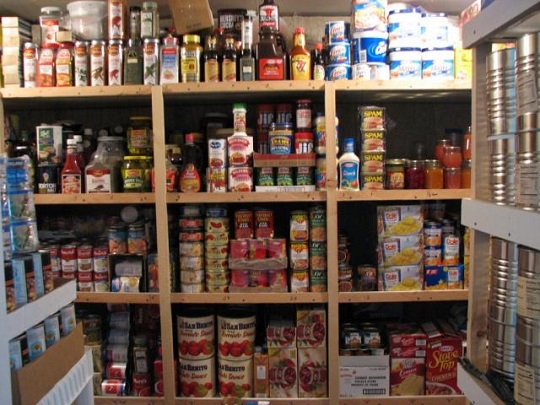
Or if you live in an apartment, 500 lbs in each of two closets and the rest under the beds.
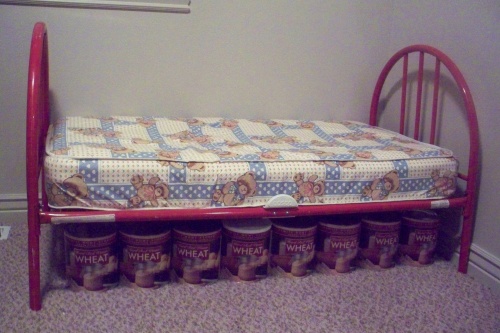
3 months of food for one.
How much would it cost? Prices vary wildly based on what you choose to store, but let’s just look at flour, 50 lbs for $14; beans, 25 lbs for $27; popcorn 50 lbs for $34, and 50 lbs of cornmeal for $20. That’s about 50 cents a pound--way cheaper than those TV dinners you’re buying at the store. Considering you will need oil, spices, sugar, cocoa, coffee or whatever, let’s call it $1/lb. But that’s still $2,000!
Maybe. First, remember you’re not supposed to be buying food at all. Buying uses scarce money, ties you to the consumer/money system, and doesn’t perpetually renew itself. Again: MAKE food, don’t buy it.
But supposing you have to buy it, or are storing things you can’t grow, like coffee, sugar, and rice, the cost of a storage meal for 4 is $2. Cost per day is $6. Even in Depressions, during wars, in the poorest and most desperate parts of your own city, people find and spend such small sums every day. Starbucks costs $4 a drink. Smoking $6/pack. Cable $2/day. Somehow, somewhere, you can find some part of this expense and stabilize your situation. I know because I’ve lived on the streets, in my car, under bridges, and I’ve done it. So can you.
This is well and good, you say, but I don’t have a ¼ acre, or at least one I’m allowed to use. I live in a condo, an apartment, with my mother, or under the stern eye of the housing association board. So do millions of others. Russia before collapse was a good example: millions lived in looming apartment flats in expansive cities not unlike our own, and like us, there was neither ownership nor space to garden. Nevertheless, it was estimated that the 10% of land allocated to kitchen gardens produced 90% of Russian domestic food. How did they do it?
First, they planted the areas around the apartments as a sort of community garden. This was as simple as having no one meddling to stop them. Second, there was a long tradition of Dacha gardens where they arranged access to a small plot of land in the country, riding the bus or train there in the morning and home at night with bags of produce. Britain has a similar tradition with their “Allotment” of space in the community garden.
In the modern U.S., suburbanization and collapsed urbanization has created nothing but small, unused plots of land everywhere on the landscape, conveniently with easy access, good soil, great drainage, dry storage, and fresh running water built-in.
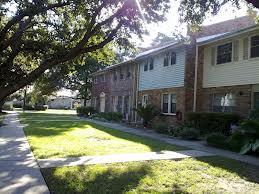
About 800 sq. feet
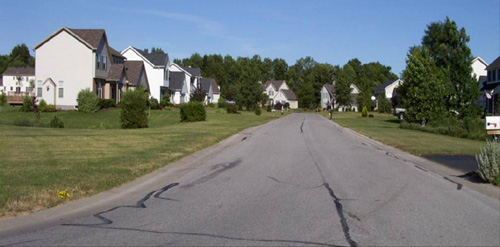
About 10 acres including the houses. These front yards are about 1/10th acre.
No access? There was a landless gardener who traded garden produce for access to his neighbor’s yards. He now runs a business selling the surplus.
It’s not very different in urban settings but can be harder to arrange. Nationwide there are ever-more urban gardening initiatives on the enormous quantity of vacant lots. The Greening of Detroit
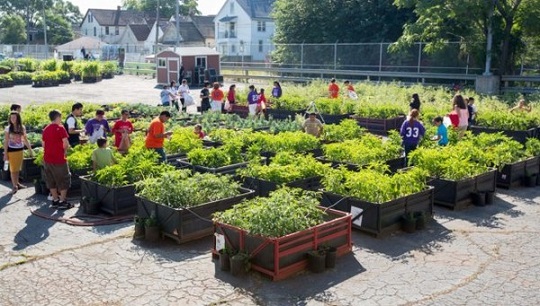
GM Orion aids recycle of old Cadillac plant for urban gardening in Detroit
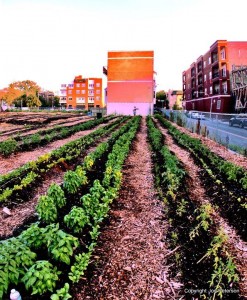
Chicago’s Peterson Garden Project – Built for Victory
But you say none of these are possible and you have nothing but a balcony.
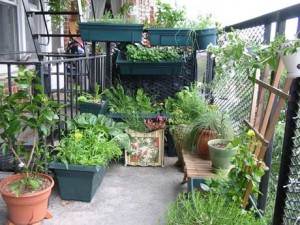
Sky High Gardens
Fine for all you rich people who have 16 square feet somewhere, but what if you live in a van down by the river?
Easy. Don’t ask; don’t get permission, just take your concord vines and nasturtium seeds, ragusa roses and wild apples down to the train tracks, to the back of the city park and plant them where you bury your food buckets. No one will recognize them. No one will care. You’re unemployed anyway so you’ve got plenty of time. Guerrilla_gardening
Will this work in downtown Hooverville in the 20-year Depression? Yes. If you’re evicted? Yes. Will it work in a war? Yes.
That’s what I mean by creating food security by planning for the world NOT to end. Because it won’t. That’s what I mean by doing something. Not buying something, staking your life on money and the good will of the next guy, not being a consumer, but PRODUCING something. In an unstable world you can put your life back in your own hands if only you apply yourself and try.
These directions suit my zone in the northeast, but with different methods the same is possible anywhere. Permaculture specializes in converting rocky hills and desert climates to food forests:
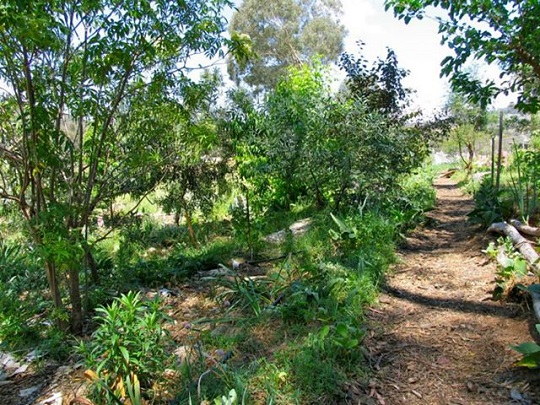
Houston Permaculture
Or the hot plains of the south, made shelter like high tunnels are ideal, easily replicated with a hacienda plan or dead branches for a patio ramada filled with prickly pear and barrel cactus:
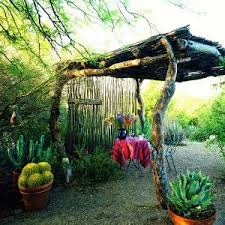
blissbloggin.blogspot.com
The bitter cold of Maine and Canada is productive as anywhere with short-season Siberian apples and hoop houses. Master gardener Elliot Coleman has developed a way to garden through Maine winters with no added heat. Four-Season Harvest: Organic Vegetables from Your Home Garden All Year Long
Seen Machu Picchu? I guarantee where you live is easier to garden than this:
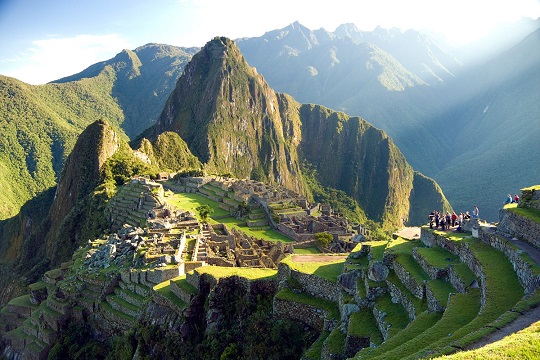
The temptation to assume that the world will either go on normally or end abruptly is strong, perhaps because both assumptions require no work. However, time is all about change. Changes you may want and prepare for, but also changes you may not like or have prepared for. By looking to history with a dispassionate eye we can discover the most likely changes, like unemployment, or what were the most helpful things in dramatic but uncommon experiences, like war and depression.
Food security is just one aspect of owning and stabilizing your life, but a useful one. Although not as universal in use as money, yet food stores can be safer, a better comfort, and more stable source of value in financial turmoil like we see today. If you learn to make your own food you have a skill, a source of income, a way to prepare at no cost, and a way to both trade and connect with your neighbors--which may be the ultimate wealth in uncertain times.
So the markets just crashed another 20% in many parts of the world:
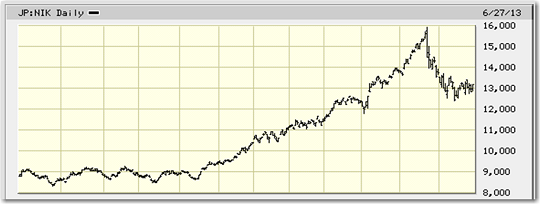
What have you been doing lately?
copyright 2013 by Eric A.
If you missed Part 1: The Sky Is (not) Falling: a “Little More Chicken” Tale (July 9, 2013)
Things are falling apart--that is obvious. But why are they falling apart? The reasons are complex and global. Our economy and society have structural problems that cannot be solved by adding debt to debt. We are becoming poorer, not just from financial over-reach, but from fundamental forces that are not easy to identify or understand. We will cover the five core reasons why things are falling apart:
 1. Debt and financialization
1. Debt and financialization2. Crony capitalism and the elimination of accountability
3. Diminishing returns
4. Centralization
5. Technological, financial and demographic changes in our economy
Complex systems weakened by diminishing returns collapse under their own weight and are replaced by systems that are simpler, faster and affordable. If we cling to the old ways, our system will disintegrate. If we want sustainable prosperity rather than collapse, we must embrace a new model that is Decentralized, Adaptive, Transparent and Accountable (DATA).
We are not powerless. Not accepting responsibility and being powerless are two sides of the same coin: once we accept responsibility, we become powerful.
Kindle edition: $9.95 print edition: $24 on Amazon.com
To receive a 20% discount on the print edition: $19.20 (retail $24), follow the link, open a Createspace account and enter discount code SJRGPLAB. (This is the only way I can offer a discount.)
| Thank you, Jay H. (silver coin), for yet another superbly generous contribution to this site -- I am greatly honored by your steadfast support and readership. | Thank you, Robert B. ($15), for yet another most excellently generous contribution to this site -- I am greatly honored by your steadfast support and readership. |



























